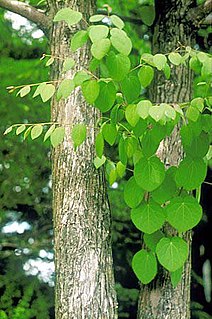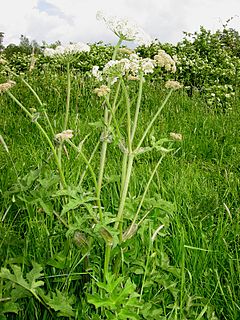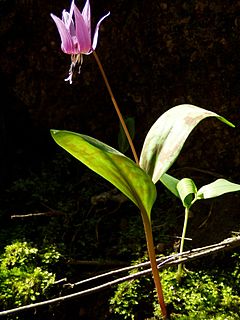
Cercidiphyllum is a genus containing two species of plants, both commonly called katsura. They are the sole members of the monotypic family Cercidiphyllaceae. The genus is native to Japan and China and unrelated to Cercis (redbuds).

Heracleum sphondylium, commonly known as hogweed, common hogweed or cow parsnip, is a herbaceous perennial or biennial plant, in the umbelliferous family Apiaceae that includes fennel, cow parsley, ground elder and giant hogweed. It is native to Europe and Asia. The common name eltrot may also be applied, but is not specific to this species. Umbelliferous plants are so named because of the umbrella-like arrangement of flowers they produce. The North American species Heracleum maximum is sometimes included as a subspecies of H. sphondylium.

Desmodium is a genus in the flowering plant family Fabaceae, sometimes called tick-trefoil, tick clover, hitch hikers or beggar lice. There are dozens of species and the delimitation of the genus has shifted much over time.

Erythronium dens-canis, the dog's-tooth-violet or dogtooth violet, is a bulbous herbaceous perennial flowering plant in the family Liliaceae, growing to 25 cm (10 in). It is native to central and southern Europe from Portugal to Ukraine. It is the only naturally occurring species of Erythronium in Europe. Despite its common name, it is not closely related to the true violets of genus Viola.
In botanical nomenclature, autonyms are automatically created names, as regulated by the International Code of Nomenclature for algae, fungi, and plants that are created for certain subdivisions of genera and species, those that include the type of the genus or species. An autonym might not be mentioned in the publication that creates it as a side-effect. Autonyms "repeat unaltered" the genus name or species epithet of the taxon being subdivided, and no other name for that same subdivision is validly published. For example, Rubus subgenus Eubatus is not validly published, and the subgenus is known as Rubus subgen. Rubus.

Agropyron fragile is a plant species in the family Poaceae.

Vincetoxicum is a genus of plants in the family Apocynaceae. Although the species in Vincetoxicum have sometimes been included in Cynanchum, chemical and molecular evidence shows that Vincetoxicum is more closely related to Tylophora.

Farfugium japonicum is a species of flowering plant in the family Asteraceae, also known as leopard plant, green leopard plant or tractor seat plant. It is native to streams and seashores of Japan, where it is called tsuwabuki (石蕗).
The Elmhurst Great Western Prairie (EGWP) is a six-acre, one mile long prairie remnant located immediately north of the Illinois Prairie Path in Elmhurst, Illinois. The EGWP has been maintained largely by volunteers since 1977 and is owned by the Elmhurst Park District.

Equisetum hyemale is a perennial herbaceous vascular plant in the horsetail family Equisetaceae. It is a native plant throughout the Holarctic Kingdom, found in North America, Europe, and northern Asia.

Eupatorium japonicum, known as fragrant eupatorium in English and 白头婆 bai tou po, in Chinese, is a herbaceous plant species in the family Asteraceae. It is native to China, Japan and Korea.

Veronicastrum is a genus of flowering plants in the family Plantaginaceae. In some taxonomy systems, Veronicastrum species have been placed within the genus Veronica. The most commonly cultivated species is Veronicastrum virginicum, which is native to the Eastern parts of North America. Veronicastrum has previously been part of the family Scrophulariaceae. However, following recent genetic studies, several genera were transferred to other families including Veronicastrum, transferred to Plantaginaceae.

Cercidiphyllum japonicum, known as the katsura, is a species of flowering tree in the family Cercidiphyllaceae native to China and Japan. It is sometimes called caramel tree for the light caramel smell it emits during leaf fall.

Polypodium virginianum, commonly known as rock polypody, rock cap fern, or common polypody, is a small evergreen species of fern native to the Eastern United States and Canada. It generally grows on rocks and occasionally on tree roots in nature.

Erythronium sibiricum is a bulbous perennial plant in the lily family Liliaceae, commonly known as the Siberian fawn lily or Siberian trout lily.
sibiricum is a species name, "of Siberia." Some genera associated with this name are:

Veronicastroside is a flavone, a type of flavonoid. It is the 7-O-neohesperidoside of luteolin. It can be found in Veronicastrum sibiricum var. japonicum and in Teucrium gnaphalodes.

Antidesma japonicum is a shrub in the family Phyllanthaceae. It is found in Southeast Asia, China and Japan. It provides food and fuel. A. japonicum has two accepted varieties: the nominate variety, A. japonicum var. japonicum; and the robustius variety, A. japonicum var. robustius.
Hypericum septestum is an extinct species of the genus Hypericum that was present during the Oligocene and Miocene epochs. Its holotype is a fossil seed from the Lower Oligocene that was collected in Western Siberia in 1965, and fossils of the species has also been found in other parts of Russia and in the Czech Republic.















